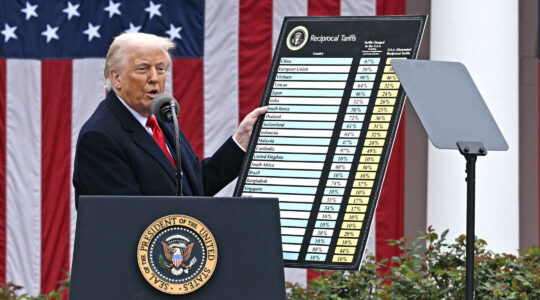WASHINGTON (JTA) — One thing we know about elections is that Jewish voters can make a difference. Take Florida: The Sunshine State’s Jewish voters helped deliver its critical electoral votes to Barack Obama in 2008 and 2012. Problematic ballots in heavily Jewish Broward County may have clinched George W. Bush’s win in 2000.
In years past I have sat among crowds rallied by Jewish campaign surrogates in packed synagogues in Ohio and bingo halls in Florida, and I’ve followed canvassers searching for mezuzahs in neighborhoods known for having large Jewish populations.
Severe limits on in-person campaigning imposed by the coronavirus pandemic means we’re not likely to be bringing you those stories this season. But a very different election year doesn’t mean the Jewish vote in swing states is less important.
This week, I asked people working to get out the Jewish vote — partisan and nonpartisan — where they’re concentrating their efforts, how much they’re planning to spend, what adjustments they’re making because of the pandemic and what is preoccupying them down-ballot. Here’s what they told me.
Democratic Jewish groups have a presence in more states than Republicans
The Republican Jewish Coalition appears to have the most advanced operation in place. With $10 million pledged to reelect Donald Trump and secure GOP control in Congress, that may not be a surprise.
The RJC’s get-out-the-vote operation already has four workers on staff in Florida, according to Matt Brooks, its executive director, and volunteers have made 300,000 phone calls to Jewish voters in swing states — a preliminary round of phone banking where the goal is not persuasion but identification, to see how committed a voter is to reelecting Trump and what issues they are considering ahead of Election Day. This lays the ground for more calls and texts later in the season that are tailored to the individual voter.
But with Trump’s polling in freefall, the group doesn’t have that many states to direct that energy. Brooks told me his swing-state operation was focusing on Florida, Ohio, Arizona, Pennsylvania and Georgia.
“We’re monitoring and looking at and ready to pivot to see how Michigan and Wisconsin continue to shape up,” he added.
Brooks said the RJC chose those states because the vote there is “competitive.” That’s notable: Trump’s 2016 victory included narrow wins in Wisconsin, Michigan, Pennsylvania, Florida and Arizona.
Including Georgia and Ohio in the mix indicates the deep trouble Trump is in. In 2016, he won Georgia by 5 points and Ohio by 8.
From Brooks’ map it would appear that the RJC doesn’t think there’s a chance for Trump to win in Michigan or Wisconsin. Polls show Joe Biden leading Trump in both states by double digits.
Meanwhile, the Jewish Democratic Council of America has a much more expansive map. In addition to the five states the RJC is targeting, along with Michigan and Wisconsin, the JDCA says it is ready to target Jewish voters in Colorado, Maine, Minnesota, Nevada, New Hampshire, North Carolina and Virginia — a 14-state plan, as director Halie Soifer put it.
Soifer said she hoped to spend over $1 million and as much as $5 million in pushing out the vote.
“They are the states where we think the Jewish vote can make a difference in the presidential and key Senate and House elections,” she said.
JDCA has organized a number of webinars, and has launched phone banking. Soifer told me she hopes to reach “hundreds of thousands, if not over a million” Jewish voters. “First it will be persuasion methods, and then get out the vote,” she said.
The tea on the down-ballot
The political action committee associated with the Democratic Majority for Israel is planning to highlight Biden’s pro-Israel record in a digital campaign. (The RJC already launched a video, titled “Sunrise,” that calls Trump “the most pro-Israel president in history.”)
But the PAC’s emphasis will be down-ballot, Mellman said, because that’s where it makes more sense to spend money; both presidential campaigns have plenty of resources already. The messaging down-ballot will not necessarily be about Israel, he said, but about issues of importance to local voters.
During the primaries, the PAC has already run ads targeting opponents of its favored candidates on themes that have nothing to do with Israel. Its $1.5 million spent to protect veteran N.Y. Rep. Eliot Engel included ads raising the fact that his challenger, Jamaal Bowman, had an unpaid tax bill. (Bowman has declared victory in that race, but Engel is waiting out the counting of the mail-in ballots.)
Mark Mellman, the Democratic Majority for Israel’s president and CEO, has proven to be a prodigious fundraiser and said his group would be spending in the millions of dollars in a broad campaign. (He declined to be more specific on the amount.)
“We will be on TV, we will be in the mail, we will be on the telephone, we will be digital,” he said. “We will be in every form of communication known to human beings.”
When it comes to the Senate, Republicans have 23 seats up for reelection, while the Democrats have only 12. That means Republican Jewish groups must be on the defensive, especially as Trump’s sinking popularity threatens to derail down-ballot Republicans, while Democratic groups can focus on flipping seats.
This week, the Jewish Democratic Council of America added 17 names to its congressional endorsements, bringing the total to 89. Significantly, most of the new batch is challenging Republicans in states that Trump won in 2016, including Ohio, Georgia, Missouri, Pennsylvania, Wisconsin, Alaska, South Carolina and Tennessee. Among the 17 are four Senate candidates — Jon Ossoff in Georgia, James Mackler in Tennessee, Al Gross in Alaska and Jaime Harrison in South Carolina — challenging incumbent Republicans. Ossoff, Mackler and Gross are Jewish.
Here are some Senate races where the partisan PACs will go head to head, according to their endorsements:
- Maine: The Republican Jewish Coalition has endorsed Sen. Susan Collins; the Democratic Majority for Israel, J Street and the Jewish Democratic Council of America are backing her challenger, Sara Gideon.
- South Carolina: RJC, Sen. Lindsey Graham; JDCA and J Street, Harrison.
- Georgia: RJC, Sen. David Perdue; JDCA and J Street, Ossoff.
- Colorado: RJC, Sen. Cory Gardner; JDCA, DMFI and J Street, challenger John Hickenlooper.
- Michigan: JDCA and DMFI, Sen. Gary Peters; RJC, challenger John James.
- Arizona: RJC, Sen. Martha McSally; JDCA and J Street, challenger Mark Kelly.
The sweeping endorsements do not mean that Democratic Jewish groups are banking on their candidates winning, but it does suggest that those candidates have a chance and will force Republicans to spend defensively.
And in one notable effort, five state-level Jewish Democratic organizations are working together to influence down-ballot elections in their states. They are the Florida Democratic Party Caucus of American Jews; Jewish Democratic Women’s Salon Atlanta; Michigan Democratic Jewish Caucus; Democratic Jewish Outreach Pennsylvania; and Wisconsin Jewish Democrats.
“There are two Senate races in Georgia — Pennsylvania as you know has no U.S. Senate race,” said Jill Zipin, the founder of Democratic Jewish Outreach Pennsylvania. “So if they’re doing a phone bank for example for Ossoff, I would encourage our Jewish voters to help and call down there.”
Counting on digital
Door-to-door canvassing is not completely out of the question — hanging flyers on doorknobs is still a thing, even during a plague, as anyone living in a competitive district will tell you. And the partisan Jewish groups are also counting on the old standby, direct mail.
But the pandemic has accelerated what already was a trend of moving toward text message blasts and targeted social media ads.
“In 2008, we would go door to door and look for the mezuzah,” said Soifer, who ran Jewish outreach for Obama’s Florida campaign that year. “Now we can purchase lists of Jewish voters and with a click of a button target hundreds of thousands with digital advertising. So in some ways, the ability to reach voters has become much more efficient.”
Brooks’ RJC has rolled out the highest-profile digital campaign so far, and he said he has money to spend on broadcast and cable ads.
The Jewish Democratic Council of America has just launched two ads on social media platforms. And Mellman said he had available technology that would allow the Democratic Majority for Israel’s PAC to target individual voters depending on their known preferences.
“We have a pretty sophisticated way to figure out who the targets are that are going to be most movable, persuadable, in the House and Senate races,” he said. “We can identify those people, and we can target ads on digital directly to those people, and do the same thing with the mail and with the phones.”
In Other News
Platforming the platform: In 2016, Jewish groups denounced the inclusion in the Movement for Black Lives’ platform of a passage accusing Israel of genocide. We’ve written about how a lot of the same Jewish groups have set aside their criticism in the current moment because of what they see as the urgency of joining with BLM in facing down institutional racism and police brutality. The ‘16 platform did not bind BLM chapters. Next month, The Washington Post reports, the Movement for Black Lives is convening a national conference to revise the platform. What happens to the Israel language will be interesting to watch.
Emulating Nita: Mondaire Jones, Nita Lowey’s likely replacement in Congress, tells my colleague Shira Hanau that he is no AOC, and that he shares the outgoing rep’s love for Israel.
Vouching for vouchers: Orthodox Jewish groups declare a victory in a Supreme Court decision that extends government aid to religious schools. Hanau examines the consequences.
WORTH A LOOK

Rep. Elissa Slotkin speaks at a news conference in Washington. (Michael Brochstein/Echoes Wire/Barcroft Media via Getty Images)
I followed Elissa Slotkin, the freshman Michigan Democrat, around last year; she’s a pothole politician, hyperfocused on local needs. But she’s also a former CIA analyst and top Pentagon official, and the Democratic leadership is calling on her skills to make sense of why Trump has appeared to be slow to react to an apparent Russian scheme to pay for the killing of American troops. At The New York Times, Emily Cochrane talks to Slotkin about how she “toggles” between her previous and current self.
TWEET SO TWEET
Soner Cagaptay, a fellow at the Washington Institute for Near East Policy, resurrects a Soviet- era ethnic “types” sheet to identify suspects. Matthew Zeitlin, a reporter, is among a number of Jewish tweeps who see something strangely familiar about the Jewish “type.”
STAY IN TOUCH
Share your thoughts on The Tell, or suggest a topic for us. Connect with Ron Kampeas on Twitter at @kampeas or email him at thetell@jta.org.
JTA has documented Jewish history in real-time for over a century. Keep our journalism strong by joining us in supporting independent, award-winning reporting.







